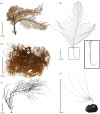Bathymetric evolution of black corals through deep time
- PMID: 37788705
- PMCID: PMC10547549
- DOI: 10.1098/rspb.2023.1107
Bathymetric evolution of black corals through deep time
Abstract
Deep-sea lineages are generally thought to arise from shallow-water ancestors, but this hypothesis is based on a relatively small number of taxonomic groups. Anthozoans, which include corals and sea anemones, are significant contributors to the faunal diversity of the deep sea, but the timing and mechanisms of their invasion into this biome remain elusive. Here, we reconstruct a fully resolved, time-calibrated phylogeny of 83 species in the order Antipatharia (black coral) to investigate their bathymetric evolutionary history. Our reconstruction indicates that extant black coral lineages first diversified in continental slope depths (∼250-3000 m) during the early Silurian (∼437 millions of years ago (Ma)) and subsequently radiated into, and diversified within, both continental shelf (less than 250 m) and abyssal (greater than 3000 m) habitats. Ancestral state reconstruction analysis suggests that the appearance of morphological features that enhanced the ability of black corals to acquire nutrients coincided with their invasion of novel depths. Our findings have important conservation implications for anthozoan lineages, as the loss of 'source' slope lineages could threaten millions of years of evolutionary history and confound future invasion events, thereby warranting protection.
Keywords: abyss; adaptations; antipatharia; shelf; slope; ultraconserved elements.
Conflict of interest statement
We declare we have no competing interests.
Figures


References
-
- Campoy AN, Addamo AM, Machordom A, Meade A, Rivadeneira MM, Hernández CE, Venditti C. 2020. The origin and correlated evolution of symbiosis and coloniality in scleractinian corals. Front. Mar. Sci. 7, 461. ( 10.3389/fmars.2020.00461) - DOI
-
- Ord TJ, Hundt PJ. 2020. Crossing extreme habitat boundaries: jack-of-all-trades facilitates invasion but is eroded by adaptation to a master-of-one. Funct. Ecol. 34, 1404-1415. ( 10.1111/1365-2435.13600) - DOI
-
- Gaither MR, Violi B, Gray HWI, Neat F, Drazen JC, Grubbs RD, Roa-Varón A, Sutton T, Hoelzel AR. 2016. Depth as a driver of evolution in the deep sea: insights from grenadiers (Gadiformes: Macrouridae) of the genus Coryphaenoides. Mol. Phylogenet. Evol. 104, 73-82. ( 10.1016/j.ympev.2016.07.027) - DOI - PubMed
Publication types
MeSH terms
Associated data
LinkOut - more resources
Full Text Sources

